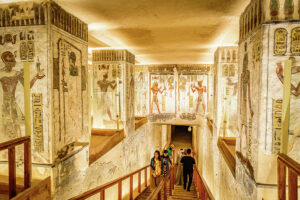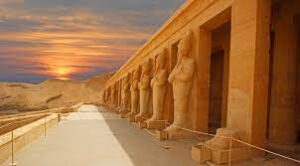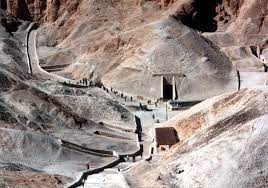The Valley of the Kings is a famous archaeological site in Egypt, known for its numerous tombs of pharaohs and nobles from the New Kingdom period. It’s located on the west bank of the Nile River near Luxor and contains some of the most well-preserved and decorated tombs in ancient Egypt, including the tomb of Tutankhamun.
Along the west bank of the Nile River, amidst the arid landscape of Luxor, lies a sacred burial ground that has captivated the
world for centuries—the Valley of the Kings. This archaeological wonder, known as the burial place of many pharaohs from the
New Kingdom of ancient Egypt, beckons travelers to step back in time and explore the mysteries and splendors of one of the most iconic historical sites on Earth.
To see videos click here: https://www.britannica.com/video/179812/Overview-Valley-of-the-Kings-Egypt
Unveiling History’s Treasures
The Valley of the Kings served as the burial ground for pharaohs of the New Kingdom period, spanning from the
16th to the 11th century BCE. These rulers sought to create tombs that would safeguard their bodies and possessions for eternity,
ensuring their journey to the afterlife would be a prosperous one.
What sets the Valley of the Kings apart is the intricate design and decoration of its tombs. Carved deep into the limestone cliffs,
these underground chambers feature elaborate hieroglyphics, colorful murals, and stunning reliefs that depict scenes from
ancient Egyptian mythology and religious beliefs.

Each tomb was meticulously crafted to serve as a gateway to the afterlife, equipped with passages, chambers, and burial
chambers filled with treasures and offerings for the deceased. The most famous tomb discovered in the Valley of the Kings is
that of Tutankhamun, whose burial chamber unveiled a treasure trove of artifacts that captivated the world.
Discovered by archaeologist Howard Carter in 1922, the tomb of Tutankhamun — often referred to as King Tut — caused a sensation
in the world of archaeology. Untouched for over 3,000 years, the tomb revealed a wealth of artifacts, including the iconic golden
mask that adorned the young pharaoh’s mummified remains.
Despite ruling for a relatively short period, Tutankhamun’s tomb provided invaluable insights into the burial practices and
beliefs of ancient Egypt. Today, visitors from around the globe flock to the Valley of the Kings to marvel at the splendor of
King Tut’s tomb and the treasures it contained.
Royal Tombs and Pharaonic Splendor
The Valley of the Kings served as the final resting place for numerous pharaohs, including the famous Tutankhamun and Ramses II.
Carved into the rocky hillsides, these elaborate tombs showcase the exquisite craftsmanship and artistic prowess of ancient Egyptian artisans. Adorned with intricate hieroglyphics, vivid murals, and precious artifacts, the tombs provide a mesmerizing glimpse into the religious beliefs and rituals of a civilization that flourished over 3,000 years ago.
Hieroglyphics and Religious Symbolism
The walls of the tombs are adorned with intricate hieroglyphics, offering a visual narrative of the pharaoh’s journey to the afterlife.
Scenes depicting religious rituals, mythological stories, and the pharaoh’s interactions with various deities provide insight into
the spiritual beliefs that guided ancient Egyptian society.
Preservation Efforts and Visitor Experience
In recent years, efforts to preserve the Valley of the Kings have been intensified to protect these ancient wonders for future generations. Conservation measures, including controlled visitor access and temperature regulation, aim to safeguard the delicate
murals and structures that have withstood the test of time.
While the Valley of the Kings continues to be a source of fascination for historians and archaeologists alike, preserving these ancient treasures remains a constant challenge. Conservation efforts are underway to protect the delicate paintings and structures
within the tombs from the ravages of time and tourism.

Conclusion
As we stand in awe amid the towering cliffs of the Valley of the Kings, we are transported back in time to an era of gods and pharaohs,
where life and death were intertwined in a tapestry of myth and legend. The tombs of this ancient necropolis serve as silent
witnesses to the grandeur and splendor of Egypt’s glorious past, inviting us to embark on a journey of discovery and enlightenment.
In the Valley of the Kings, history comes alive, and the echoes of the past resonate through the ages, reminding us of the
enduring legacy of one of the world’s greatest civilizations.
When visiting the Valley of the Kings, consider hiring a knowledgeable guide to enhance your experience and provide historical
context to the intricate details found within the tombs. Remember to respect the preservation efforts by adhering to guidelines and restrictions imposed within the archaeological site.
The Valley of the Kings stands as an enduring testament to the grandeur and mystique of ancient Egypt. As you wander through
the hallowed corridors and gaze upon the elaborate burial chambers, you can’t help but feel a profound connection to the
rich tapestry of history woven into the very fabric of this sacred valley.
Embark on a journey through time and immerse yourself in the marvels of the Valley of the Kings—an archaeological treasure trove that continues to unlock the secrets of Egypt’s illustrious past.




